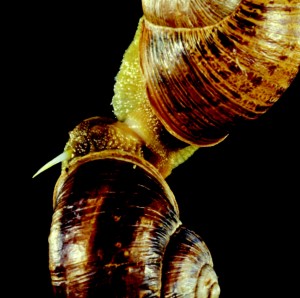
In classical mythology, Cupid carries two types of arrows: one with a sharp golden tip and one with a blunt tip made of lead. Those struck with the golden arrow are filled with uncontrollable desire while those wounded with the lead arrow are filled with revulsion. In these modern times, we humans are less likely to rely on a winged cherub carrying a quiver full of arrows to help us find love than on online dating sites and Tinder. That’s not to say that projectile weapon systems like the bow and arrow have become obsolete in affairs of the heart. Some species of land snails shoot love darts at their mating partners to increase their reproductive success.
As violent as it sounds, stabbing their mating partner with a love dart improves the likelihood that a snail will father offspring. These sharp and pointy darts are made of a crystalline form of calcium carbonate called aragonite and coated with mucus. If the dart hits its target, chemicals in the mucus coating are released into the recipient snail’s blood stream. These chemicals serve as signals that trick the female reproductive organs to divert the shooter’s sperm away from the sperm digesting organs and into the sperm storage organs where they can fertilize eggs later. While love darts are known to carry clear benefits for the shooter, not a lot is known about how being hit by a love dart affects the recipient. For the first time, scientists have experimentally studied the costs of this violent and traumatic behaviour to the individual being stabbed. Continue reading

